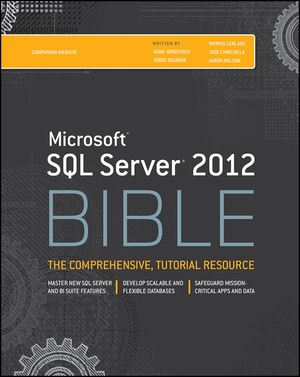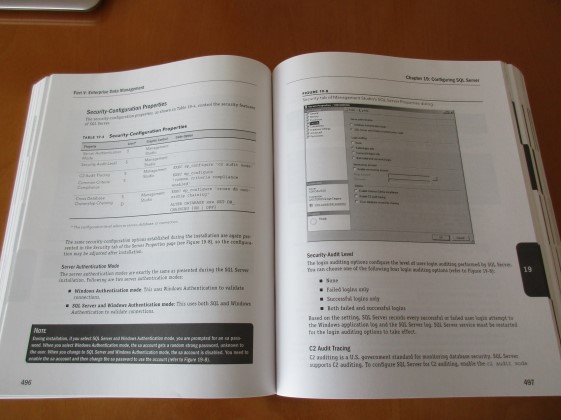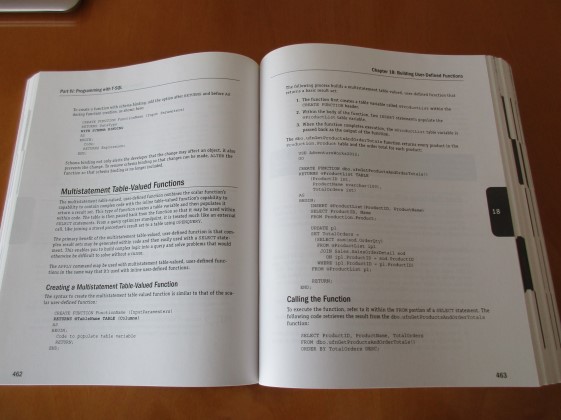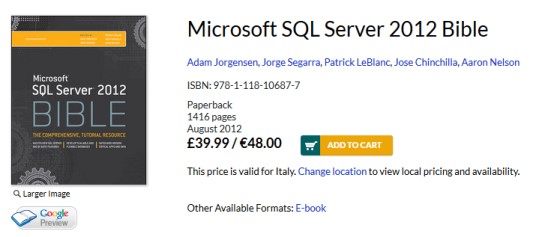
Dopo un po’ di tempo torno ad occuparmi di libri per segnalare un’ottima guida della Wiley su SQL Server 2012 che mi è venuta in soccorso nella preparazione dell’esame di certificazione 70-461 (“Querying Microsoft SQL Server 2012”) di cui ne ho parlato nel mio ultimo post.
Si tratta di un tomo da quasi 1.400 pagine, non per nulla definito “Bible”, ovvero “Microsoft SQL Server 2012 2012 Bible”, scritto a più mani da diversi autori.
È un manuale oltremodo omnicomprensivo, dato che affronta sia argomenti di sviluppo (T-SQL in tutte le sue sfaccettature), sia di pura amministrazione (pane quotidiano di chi lavora come DBA).
Ma non solo, diversi capitoli finali (tra i ben 59 totali) trattano anche di Business Intelligence, quindi Integration, Reporting e Analysis Services.
Quello che mi è molto piaciuto di questo libro è la sua concisione; non ci si perde troppo in pagine discorsive teoriche, ma si passa subito agli esempi, tanti e sempre calzanti.
Certo, magari l’approfondimento non sarà paragonabile ad un libro “Inside” di Itzik Ben-Gan o di Kalen Delaney, ma direi che è sufficiente per l’80/90% delle situazioni professionali su cui ci si può imbattere.
Per approfondire maggiormente (come ho fatto io per la parte XML ad esempio) ci si può rivolgere sempre ai ben fatti Books On Line di SQL Server.
L’inglese utilizzato è perfettamente comprensibile anche dai non madrelingua, ed inframmezzati nei capitoli ci sono dei piccoli (ma impagabili) box riportanti le migliori best practices di sviluppo.
Il layout grafico è eccellente e piacevole, sia per scelta del font che per impaginazione generale.
Riporto qua sotto un paio di immagini di esempio.


Lo spessore è notevole, come si vede da questa foto.

Diciamo che non è libro tascabile, ma trova il suo spazio ideale sulla scrivania a fianco del pc (o sul comodino ma utilizzando un bel cuscino di appoggio!).
Ottima la rilegatura, molto flessibile (lo si riesce a tenere aperto sulla scrivania senza alcun problema), con carta semi-patinata ma resistente e copertina sottile ma piuttosto robusta.
Insomma, un gran bel libro su SQL Server 2012, che non deve mancare a chi sviluppa con questo database e soprattutto desideri avere un punto di riferimento globale per tutto ciò lo riguarda.
Sommario
Introduction
Part I: Laying the Foundations
3 - Chapter 1: The World of SQL Server
15 - Chapter 2: Data Architecture
31 - Chapter 3: Installing SQL Server
71 - Chapter 4: Client Connectivity
81 - Chapter 5: SQL Server Management and Development Tools
Part II: Building Databases and Working with Data
111 - Chapter 6: Introducing Basic Query Flow
143 - Chapter 7: Relational Database Design and Creating the Physical Database Schema
173 - Chapter 8: Data Types, Expressions, and Scalar Functions
213 - Chapter 9: Merging Data with Joins, Subqueries, and CTEs
249 - Chapter 10: Aggregating, Windowing, and Ranking Data
271 - Chapter 11: Projecting Data Through Views
291 - Chapter 12: Modifying Data In SQL Server
Part III: Advanced T-SQL Data Types and Querying Techniques
325 - Chapter 13: Working with Hierarchies
339 - Chapter 14: Using XML Data
367 - Chapter 15: Executing Distributed Queries
Part IV: Programming with T-SQL
389 - Chapter 16: Programming with T-SQL
431 - Chapter 17: Developing Stored Procedures
453 - Chapter 18: Building User-Defined Functions
Part V: Enterprise Data Management
469 - Chapter 19: Configuring SQL Server
531 - Chapter 20: Policy Based Management
547 - Chapter 21: Backup and Recovery Planning
585 - Chapter 22: Maintaining the Database
615 - Chapter 23: Transferring Databases
635 - Chapter 24: Database Snapshots
647 - Chapter 25: Asynchronous Messaging with Service Broker
661 - Chapter 26: Log Shipping
685 - Chapter 27: Database Mirroring
727 - Chapter 28: Replicating Data
745 - Chapter 29: Clustering
769 - Chapter 30: Configuring and Managing SQL Server with PowerShell
801 - Chapter 31: Managing Data in Windows Azure SQL Database
Part VI: Securing Your SQL Server
833 - Chapter 32: Authentication Types in SQL Server
841 - Chapter 33: Authorizing Securables
853 - Chapter 34: Data Encryption
861 - Chapter 35: Row-Level Security
Part VII: Monitoring and Auditing
879 - Chapter 36: Creating Triggers
909 - Chapter 37: Performance Monitor and PAL
919 - Chapter 38: Using Profiler and SQL Trace
931 - Chapter 39: Wait States
937 - Chapter 40: Extended Events
945 - Chapter 41: Data Change Tracking and Capture
967 - Chapter 42: SQL Audit
977 - Chapter 43: Management Data Warehouse
Part VIII: Performance Tuning and Optimization
995 - Chapter 44: Interpreting Query Execution Plans
1005 - Chapter 45: Indexing Strategies
1041 - Chapter 46: Maximizing Query Plan Reuse
1047 - Chapter 47: Managing Transactions, Locking, and Blocking
1097 - Chapter 48: Data Compression
1109 - Chapter 49: Partitioning
1131 - Chapter 50: Resource Governor
Part IX: Business Intelligence
1143 - Chapter 51: Business Intelligence Database Design
1155 - Chapter 52: Building, Deploying, and Managing ETL Workflows in Integration Services
1195 - Chapter 53: Building Multidimensional Cubes in Analysis Services with MDX
1223 - Chapter 54: Configuring and Administering Analysis Services
1233 - Chapter 55: Authoring Reports in Reporting Services
1261 - Chapter 56: Configuring and Administering Reporting Services
1281 - Chapter 57: Data Mining with Analysis Services
1299 - Chapter 58: Creating and Deploying BI Semantic Models
1327 - Chapter 59: Creating and Deploying Power View Reports
1347 - Index
